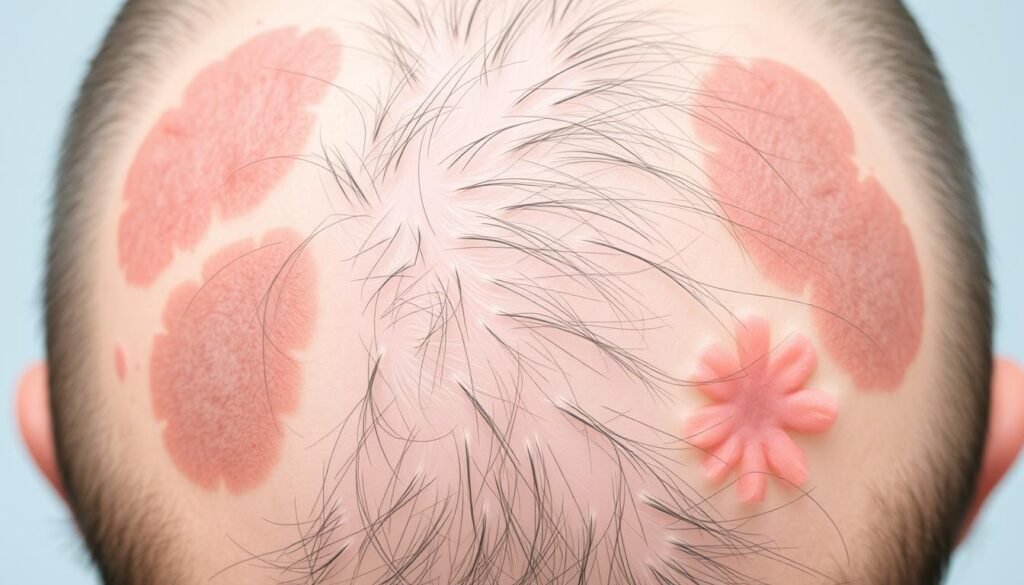An estimated 2% of new dermatology referrals in the UK and the United States are for alopecia areata. This condition causes patchy hair loss. It greatly impacts a person’s life quality. About 40 to 50% of patients start showing symptoms before turning 21. Therefore, knowing about effective alopecia areata medication is key for those wanting to get their hair and confidence back.
This guide dives into the different alopecia treatment options out there. From well-known therapies to cutting-edge medications. It stresses how treatments should fit the individual’s unique needs. It shares insights into the treatments and therapies lifting hopes for hair regrowth treatments. Plus, understanding the complex causes, risks, and symptoms helps in making informed choices for hair loss management.
Key Takeaways
- Alopecia areata impacts people from all walks of life, without favoring any race.
- With the right treatments like Baricitinib, up to a 50% improvement is seen.
- Issues like anxiety and depression are regular in patients, affecting their mental well-being.
- Tailoring the treatment to how severe the disease is key to better results.
- Having family members with alopecia areata is common in about 20% of cases.
- For more detailed treatment ideas and advice, visit available treatments.
Understanding Alopecia Areata
Alopecia areata is a common autoimmune hair loss condition. It causes sudden patchy hair loss. People of all ages, including kids and adults, may get bald patches without inflammation or scars. Around 2% might get alopecia areata during their life, which makes it pretty rare.
Men usually see symptoms at age 32, and women at 36. No gender is more likely to get it, but it’s more common among Asian, Black, and Hispanic people. Also, those with Down syndrome and polyglandular autoimmune syndrome type 1 face higher risks of getting this hair loss condition.
Almost half of the people with alopecia areata also see changes in their nails. This condition can lead to different types of hair loss. It ranges from total scalp hair loss to losing all body hair. There are treatments available like corticosteroids and JAK inhibitors. People also use wigs, hats, or scarves as solutions.
The impact of alopecia areata on emotions and social life is huge. Understanding this condition is key. It helps us support those suffering and guides them to suitable treatments.
Causes and Risk Factors of Alopecia Areata
Alopecia areata comes from both genetics and the environment. It leads to an autoimmune response. This makes the immune system attack the hair, causing hair loss. A key factor is genetics. About 20% of people with it have family members also affected.
Many risk factors for hair loss show how complex this condition is. It mostly affects people in their teens, twenties, or thirties. Both men and women get it across all races and ethnicities. If a close family member has it, your risk increases, especially if they lost hair early.
Autoimmune diseases link closely to alopecia areata. Conditions like psoriasis and thyroid disease raise the risk of getting it. Also, people with asthma or hay fever are more likely to develop alopecia areata.
Lifestyle plays a role too. Smokers are at a higher risk than nonsmokers. Considering 1 in 50 people might get this hair loss, lifestyle choices matter.

Symptoms of Alopecia Areata
The main sign of alopecia areata is quick hair loss, leading to bald spots. This might happen anywhere on the scalp or body. People often see round patches of lost hair, which look different from person to person.
Some might find hair loss signs like “exclamation mark hairs.” These are broken hairs that get narrower at the bottom. It suggests the condition could get worse.

About 10% to 20% of those with alopecia see changes in their nails. They may become pitted or brittle. Signs can include:
- Patchy hair loss, mainly on the scalp, in nearly 95% of cases.
- Loss of beard hair, happening in 28% of men.
- Sometimes, hair loss starts in the eyebrows or eyelashes, in about 3.8% of cases.
Some people feel itching or burning where hair has fallen out. This might mean more hair will be lost soon. Total hair loss on the scalp, known as alopecia totalis, is also possible. This is more common in kids and young people.
In very rare cases, alopecia universalis causes loss of all body hair. This, and unique patterns like ophiasis, show the wide range of clinical features of alopecia. It makes diagnosing alopecia diverse for skin doctors.
In brief, alopecia areata’s symptoms include obvious hair loss, nail problems, and various sensations in affected spots.
Diagnosis of Alopecia Areata
Doctors start diagnosing alopecia areata by looking at the patient closely and learning their health history. They look for the way hair loss happens, usually in spots on the scalp or face. About 6.7 million people in the US have this issue, so spotting it correctly is key.
To be sure someone has alopecia areata, doctors may use several tests. They might take a small piece of scalp to look at closely, ruling out other hair loss types. They may also check for infections that look like alopecia areata.
Certain hair patterns, known as “exclamation mark hairs,” suggest alopecia areata. These hairs are short and narrow at the bottom. Other hints include very tiny hairs or suddenly white hair. About 30% of patients have severe cases or see their hair come and go. Nearly half might see their hair return in a year, helping confirm the diagnosis.

Knowing these signs is crucial for a right diagnosis. If alopecia areata runs in the family, that’s important too. About 20% of patients have a relative with it. This information helps doctors make a good plan for treating it.
Treatment Goals for Alopecia Areata
The treatment goals for alopecia areata focus on two main areas. First, restoring hair growth is key. Second, addressing the emotional impact of hair loss is critical. Clinicians aim to set specific hair regrowth objectives. These priorities manage symptoms and enhance life quality. They include reducing inflammation and promoting hair follicle health.
Assessing medication effectiveness is essential in treatment. Different therapies have varying success rates. For example, studies show that 71% of patients with alopecia areata saw hair regrowth with triamcinolone injections. In contrast, 61% using 0.1% betamethasone foam achieved significant hair regrowth.
Responses to treatment can greatly vary among individuals. For instance, minoxidil showed a 63.6% regrowth rate, which is high compared to a placebo at 35.7%. Topical treatments like anthralin cream have a 25% success rate in severe cases. Meanwhile, latanoprost eye drops show promise in 45% of alopecia universalis cases.
Talking with dermatologists about treatment goals is vital. It helps individuals tailor options to their specific conditions. Knowing what to expect aids patients in navigating their alopecia areata journey. It builds resilience and adaptability when facing challenges.
| Treatment | Success Rate | Notes |
|---|---|---|
| Triamcinolone Acetonide Injections | 71% | Effective for subtotal alopecia areata |
| 0.1% Betamethasone Valerate Foam | 61% | More than 75% hair regrowth |
| Minoxidil | 63.6% | Compared to 35.7% in placebo group |
| 0.5%–1.0% Anthralin Cream | 25% | Cosmetic response in severe cases |
| Latanoprost Eye Drops | 45% | Positive results in alopecia universalis |
Effective Alopecia Areata Medication Treatment Options
Alopecia Areata presents unique challenges in treatment. It prompts a closer look at effective medication options. Each therapy serves different needs and can offer significant benefits for those dealing with this form of hair loss.
Intralesional Corticosteroids
Intralesional corticosteroids, especially triamcinolone acetonide, target localized patches of alopecia areata. This method shows promising results. Studies suggest about 60% of treated sites may achieve hair regrowth.
Regular injections, given four weeks apart, can lead to 47% regrowth at 12 weeks. An impressive 95% may see regrowth at 24 weeks. This option remains a top choice due to its effectiveness.
Topical Corticosteroids
Topical corticosteroids are a non-invasive first-line treatment for both kids and adults. Research indicates that proper and regular use can lead to about 70% hair regrowth in three months. These medications are key in managing alopecia areata when intense intervention isn’t needed.
Minoxidil Applications
Minoxidil for hair regrowth is popular as a supplementary treatment for alopecia areata. The topical solution is FDA-approved for general hair loss. It shows better results in less severe cases.
On average, users might start seeing hair regrowth in four to six months. This highlights the gradual progress possible with minoxidil in treating alopecia.
While exploring these options, it’s important to seek professional advice. This helps find the most suitable treatment plan for each person. For a more comprehensive overview of the condition, visit this link.
Corticosteroid Treatment Overview
Corticosteroids are key in treating alopecia areata. They come in different forms, each with its own effectiveness level. Patients can choose what best fits their needs. The main treatments include injections and topical creams.
Intralesional versus Topical
Intralesional corticosteroids, like Triamcinolone acetonide, are injected right into the scalp. This delivers high doses directly, improving hair growth. It’s best for those with localized alopecia. Topical corticosteroids are easier for self-use and often preferred for kids.
Choosing between injections or topical creams depends on the case. Including how severe the alopecia is. Oral minoxidil is another choice for tough cases. It has shown to help grow hair in those not helped by other treatments.
Oral Minoxidil Options
Oral minoxidil isn’t specially approved for alopecia areata. Yet, it’s promising in helping hair grow back. It’s worth considering if other treatments haven’t worked. This option gives hope to those with hard-to-treat alopecia.
| Treatment Method | Administration | Pros | Cons |
|---|---|---|---|
| Intralesional Corticosteroids | Injected into affected areas | Concentrated dosage; encourages fast recovery | Requires clinical visits; possible side effects |
| Topical Corticosteroids | Applied directly on the scalp | Easy application; suitable for children | May require longer use; variable effectiveness |
| Oral Minoxidil | Orally ingested | Effective for resistant cases; systemic effect | Not FDA-approved for this use; potential side effects |
Corticosteroid treatment offers various options for alopecia areata. Working with healthcare pros ensures the best method is chosen. This matches individual treatment goals and expected results.
Want to learn more about steroid injections for hair loss? Check out this resource.
Immunotherapy for Alopecia Areata
Immunotherapy is a new way to treat alopecia areata. It uses the body’s immune system to help hair grow back. Treatments like Diphencyprone (DPCP) and Squaric Acid Dibutyl Ester (SADBE) create a mild allergic reaction. This can lead to hair regrowth in 40% to 55% of patients. The success depends on several factors unique to each person.
Diphencyprone (DPCP)
DPCP works really well for those with patchy hair loss, showing improvement in 88% to 100% of cases. For severe hair loss, it works about 60% of the time. Yet, it’s less effective for complete hair loss, with success rates around 17%. The good news is, DPCP rarely fails to sensitize, happening in just 1-2% of cases. That makes it a reliable option for many people.
Squaric Acid Dibutyl Ester (SADBE)
SADBE is pricier than other treatments but it’s an important option. Like DPCP, SADBE needs close watch for side effects like skin irritation. These treatments offer personalized plans for dealing with hair loss. They bring hope to about 2% of folks who suffer from this issue.